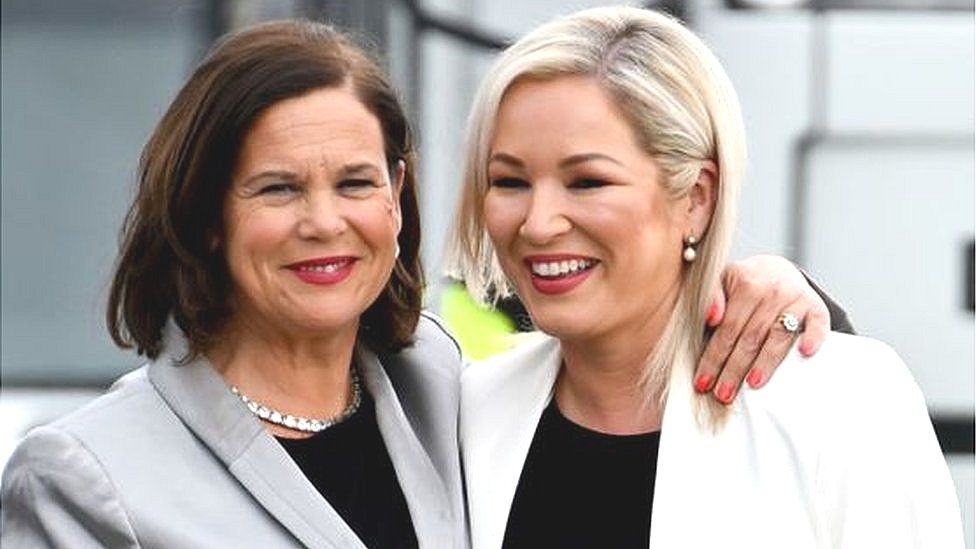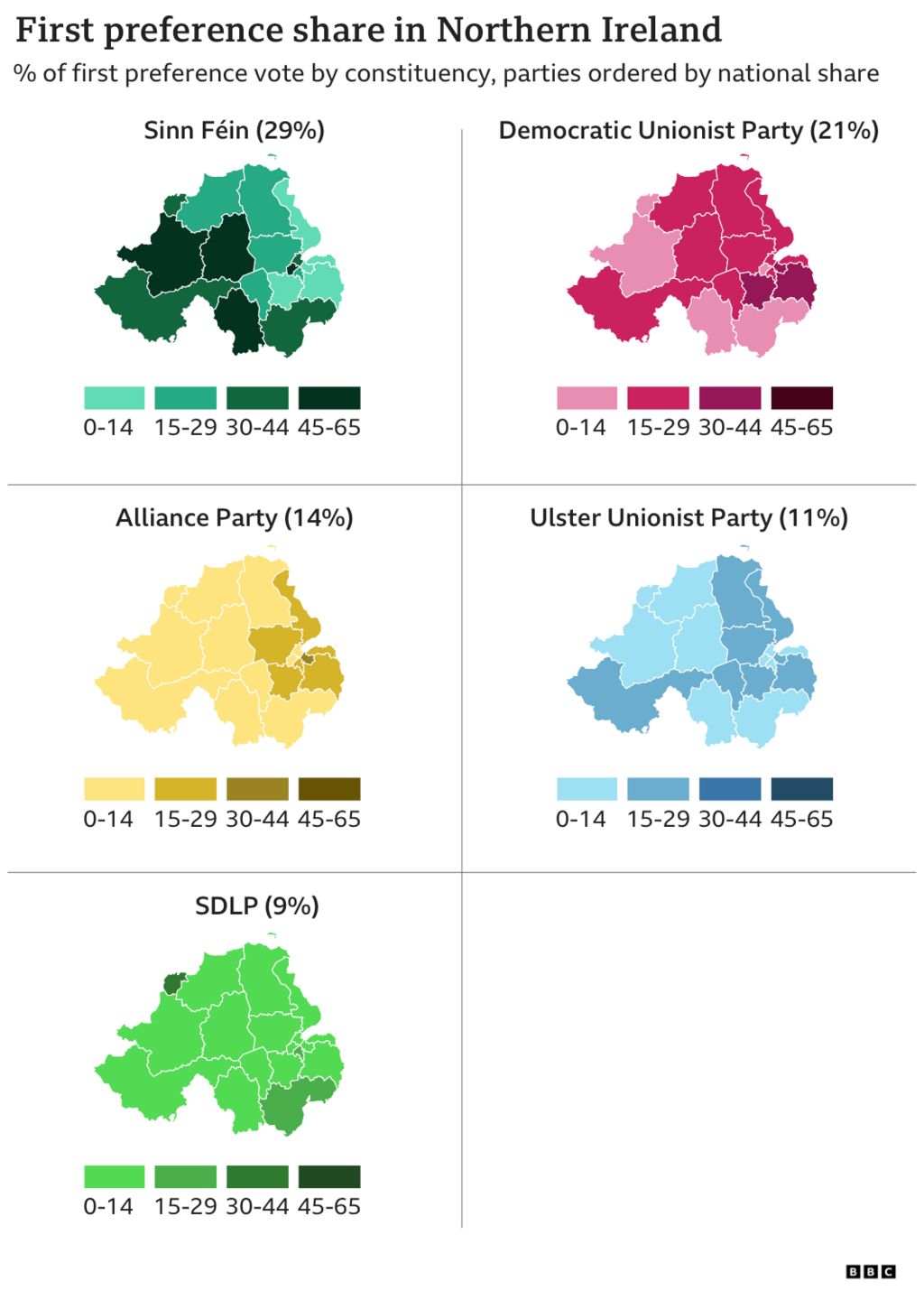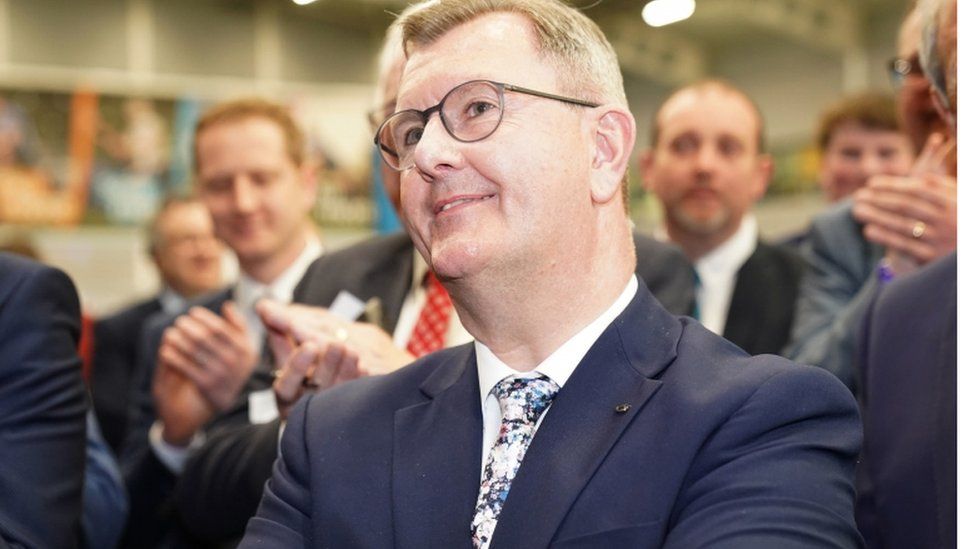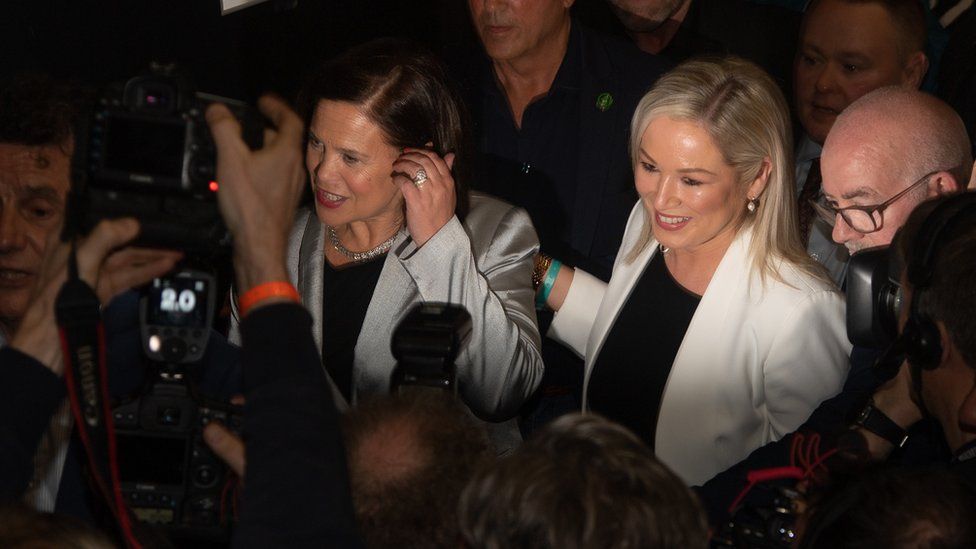Northern Ireland is on the cusp of having its first nationalist first minister, says the party’s leader.

Image source, Getty Images
Counting in the Northern Ireland Assembly election has resumed with the republican party Sinn Féin set to win the most seats for the first time.
It is vying with the Democratic Unionist Party – whose vote share dropped – for the entitlement to nominate the next first minister.
A unionist party has been the largest in government since Northern Ireland was formed in 1921.
The cross-community Alliance Party has made gains, with 47 of 90 seats filled.
The DUP won 28 seats at the last assembly election in 2017, just ahead of Sinn Féin’s 27.
Next was the SDLP with 12 seats, the UUP with 10, Alliance with eight and the Green Party with two, while People Before Profit and TUV had one MLA each.
So far this time round, Sinn Féin has 18 assembly members (Members of the Legislative Assembly MLAs), the DUP has 14, Alliance has ten, the Ulster Unionist Party (UUP) has four and the Social Democratic and Labour Party (SDLP) has three after a poor performance.
The Traditional Unionist Voice (TUV) has one seat and one independent unionist has been elected.
Counting resumed in three centres – Titanic Exhibition Centre in Belfast, Ulster University in Jordanstown and Meadowbank Sports Arena in Magherafelt – at 09:00 BST.
Sinn Féin winning the most seats would be a first for a party in Northern Ireland that designates as nationalist.
Border poll
The ultimate goal of Sinn Féin – whose leader in Northern Ireland, Michelle O’Neill, declared the election a “historic day” – is for Northern Ireland to leave the UK and become one country with the Republic of Ireland.
But a victory for Sinn Féin in this election does not mean a vote on Irish reunification – also known as a border poll – would be imminent.
The Northern Ireland Act 1998 – which followed the signing of the Good Friday peace Agreement – stated that Northern Ireland remained part of the United Kingdom and “shall not cease to be so without the consent of a majority of the people of Northern Ireland voting in a poll”.
It also stated that the Northern Ireland Secretary would agree to hold a poll if it appeared likely that a majority of people wanted a united Ireland.
Successive opinion polls suggest that is not yet the case, with the most recent, published in April, putting support at about a third.
While party leader Mary Lou McDonald said on Friday night her party was on the cusp of securing the post of first minister, she said planning for a unity referendum would come within a “five-year framework”.
Fighting it out for first minister
While the office of the first and deputy first minister is an equal one with joint power, the allocation of the titles is regarded as symbolically important.
For Sinn Féin to be installed in the role, the majority of unionist assembly members would have to agree to power-sharing, as Northern Ireland operates under a system of mandatory coalition.
But DUP leader Sir Jeffrey Donaldson has said that he will not be nominating any ministers to the executive until the issue of the Northern Ireland Protocol is resolved.

The protocol is the Brexit deal that prevents a hard Irish border by keeping Northern Ireland inside the European Union’s (EU) single market for goods.
It also creates a new trade border between Northern Ireland and the rest of the UK.
Complicated transfer system
Elections for the assembly use the single transferable vote (STV) system of proportional representation.
Voters list candidates in order of preference and once their top-ranked candidate is elected or eliminated, their vote is allocated to their next-ranked candidate.
This can lead to many stages of counting and can take many hours.
With an overall turnout of 63.6% in Thursday’s election – slightly lower than the 64.8% who voted in 2017 – Sinn Féin got 250,388 first-preferences votes, up from 224,245 last time round.
First preference results
|
Party
|
Vote share
|
Change since 2017
|
|---|---|---|
|
Sinn Féin
|
29.0%
|
+1.1%
|
|
Democratic Unionist Party
|
21.3%
|
-6.7%
|
|
Alliance Party
|
13.5%
|
+4.5%
|
|
Ulster Unionist Party
|
11.2%
|
-1.7%
|
|
Social Democratic & Labour Party
|
9.1%
|
-2.9%
|
|
Traditional Unionist Voice
|
7.6%
|
+5.1%
|
|
Green Party
|
1.9%
|
-0.4%
|
|
Aontú
|
1.5%
|
+1.5%
|
|
People Before Profit
|
1.1%
|
-0.6%
|
|
Others
|
3.7%
|
|
|
Party
|
Vote share
|
|---|---|
|
Sinn Féin
|
29.0%
|
|
Democratic Unionist Party
|
21.3%
|
|
Alliance Party
|
13.5%
|
|
Ulster Unionist Party
|
11.2%
|
|
Social Democratic & Labour Party
|
9.1%
|
|
Traditional Unionist Voice
|
7.6%
|
|
Green Party
|
1.9%
|
|
Aontú
|
1.5%
|
|
People Before Profit
|
1.1%
|
|
Others
|
3.7%
|
|
Party
|
Change since 2017
|
|---|---|
|
Sinn Féin
|
+1.1%
|
|
Democratic Unionist Party
|
-6.7%
|
|
Alliance Party
|
+4.5%
|
|
Ulster Unionist Party
|
-1.7%
|
|
Social Democratic & Labour Party
|
-2.9%
|
|
Traditional Unionist Voice
|
+5.1%
|
|
Green Party
|
-0.4%
|
|
Aontú
|
+1.5%
|
|
People Before Profit
|
-0.6%
|
The DUP’s first-preference vote dropped by 41,000 to 184,000, while the Alliance Party increased its first preference vote by about 44,000 to 116,700.
Sinn Féin vice-president Michelle O’Neill, DUP leader Sir Jeffrey Donaldson, Alliance Party leader Naomi Long and TUV leader Jim Allister were all elected on Friday.
UUP leader Doug Beattie has yet to hear if he has retained his seat.
Alliance gained seats in Lagan Valley and East Antrim.

Image source, PA Media
A number of prominent politicians have failed to gain seats:
- Green Party leader Clare Bailey failed to retain her seat in Belfast South
- Former education minister Peter Weir, of the DUP, who had been a member of the first assembly in 1998, lost his seat in Strangford
- The UUP’s Roy Beggs, who had also been elected since that post-Good Friday Agreement poll, was eliminated in East Antrim
- The SDLP’s Dolores Kelly failed to win her seat back in Upper Bann

The die has been cast

Sinn Féin are the big winners and will be returned as the largest party at Stormont.
The Alliance Party surge is continuing as well – the party came into the election the fifth largest party at Stormont and will be coming out the other side in third place.
The DUP’s percentage vote has fallen, but the party may well escape with just losing two to three seats which was much better perhaps than many of the pollsters had predicted.
The TUV is also a winner and saw its percentage vote increase, but it’s not quite clear yet whether the party will be able to tag on any extra seats.
The big loser is the SDLP – their vote has dropped and will be well below 10%.
The Ulster Unionists will probably stand still with 10 seats or so.


Image source, PACEMAKER
Protocol implications
The result of this election will have significance for the future of the Northern Ireland Protocol.
The assembly members who are elected will have to vote on whether to continue with the parts of the protocol which create the internal UK trade border.
That consent vote has to take place before the end of 2024. The vote will be decided by simple majority rather than requiring cross-community consent.
Unionist parties oppose the protocol whereas nationalists and the cross-community Alliance Party see it is an acceptable compromise to mitigate some of the impacts of Brexit.
The Northern Ireland Protocol has cast a long shadow over the election campaign following the resignation of First Minister Paul Givan in February.
The move by the DUP was in an effort to force the UK government to act over the post-Brexit trading arrangements.
Northern Ireland Secretary Brandon Lewis has indicated that the government will not be introducing legislation relating to the protocol in the Queen’s Speech next week.

SIGN UP FOR ALERTS: Get extra updates on BBC Northern Ireland election coverage

- POSTCODE SEARCH: What are the results in my area?
- NOTIFICATIONS: Sign up for Northern Ireland election alerts
- THE ASSEMBLY: How power-sharing works in Northern Ireland

-
- 12 hours ago

- 2 days ago


